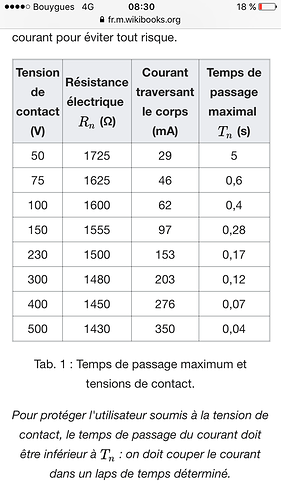I see most people are using 48v batteries. The Chinese efoils are using 36v. My controller takes up to 72V. What would be the max that you would be comfortable using?
In Germany the VDE has fixed 120V DC as the highest voltage that an adult can touch without risking his life. But for children the limit is only 60V and in wet environments even 12V, because when your skin is wet the resistance is lower. So for our case I wouldn’t risk going above 12 or 13s.
120v dc during 30s for stop breathing , no ?
What do you mean by that?
The problem is the following: I would consider a current of 100mA potentially deadly (with DC), from 40-50mA it gets uncomfortable and you will get burned skin and nails.
The amount of current flowing through your body is dependent on the voltage and your body resistance. The resistance of your body heavily depends on how wet or dry the skin is and how the current flows - if you short the battery with one hand (compared to the whole body) it will be very low resistance.
Also with higher voltage it becomes more likely that the outermost skin layer - which is responsible for most of the resistance - gets penetrated, resulting in almost unhindered current flow.
In our case we are certainly wet, often even in salt water. Then the resistance of the body can be below 1kOhm. Given 50V the current through the body is:
50V / 1000 Ohm = 0.05 A = 50mA
That is already a high value, when we go higher in voltage the resistance will drop even lower and we are quickly at around 100mA, potentially deadly. 100V or similar would be insane in this environment.
What i have read : 1k dry and 2k wet , take some time for the breathing muscles to spam and more time for the heart to stop , i look for the numbers , for Europe safety application …
Ok, yes that sounds about right, exact numbers aren’t possible anyway.
What is important is that 44.4V is a good compromise.
I have 130mA for the heart on dc current , start to feel at 2mA
Ok. So what do you think should be the maximum safe voltage for us?
We have had some discussion about the highest recommended voltage before in Risk of electric shock - Safety - FOIL.zone. And prior to that in the Safety with efoils and I think somewhere buried in the pacificmeister build info thread. I will describe my prelianary resarch below, you can read some of my linked articles if you are interested, but be warned this raises more questions instead of only answering your simple one.
I did base my personal 12S limit on the experience with voltage in that range across my wet hand and the extra low voltage directive I think it is called for DC with 60V in wet areas. But keep in mind that it‘s for wet areas and not submerged. The scientific articles PowerGlider turned up and the research you will find if you look through the sources suggest that much lower even DC voltages can pose real propblems under water.
An isolation supervisor device is in my mind the optimal solution. That is in addition to using <60V. Those circuts work by monitoring if both battery poles are galvanically isolated from the water. If not the battery gets isolated. This system would take some development though, that I would recommend only if you want to sell your project. For designing a supervisor I would start with reading [VDE 0413-8,DIN EN 61557-8-2007-12].
I was quite interested in the topic that’s why I read/skimmed those articles, too:
- Fish, Raymond M., and Leslie A. Geddes. “Conduction of electrical current to and through the human body: a review.” Eplasty 9 (2009).
- Nabours, Robert E. “Dalziel revisited.” IEEE Industry Applications Magazine 15.3 (2009).
- Smoot, A. W., and C. A. Bentel. “Electric shock hazard of underwater swimming pool lighting fixtures.” IEEE Transactions on Power Apparatus and Systems 83.9 (1964): 945-964.
- And if you can read German the following article has some more practiacal diagrams: https://www.schadenprisma.de/wp-content/uploads/pdf/1993/sp_1993_1_1.pdf
Sorry for the longwinded post, use what you think is appropiate from it.
